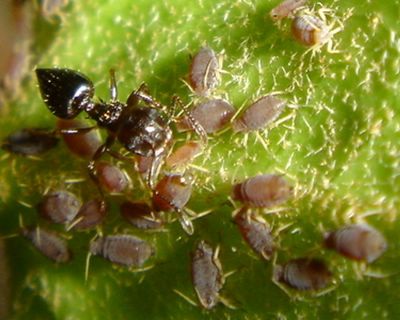Ants, Aphids and Ivy
 click to enlarge and see more photos
click to enlarge and see more photos
For the last few weeks I have been taking photographs of some ivy growing in my backyard to make a time-lapse video. While in the process, I began noticing these tiny dots on the underside of the newest leaves at the tip of the shoots. After a few days of this, I took a closer look and some close-up photos and realized that these are aphids, also known as plant lice. I also noticed that ants were usually in attendance. I have read about the mutualistic relationships between ants and aphids, but didn't expect to see such a fine example right at home.
Basically what happens is that these aphids, use their long slender mouthparts to pierce tender leaves and stems to feed on the sap. Rather than process every last bit of the fluid, they just use a portion of it and allow the remaider to pass through their alimentary canal and secrete it in the form of a sweet substance known as honeydew. Some ant species use this excess fluid for their own nutrition and in return will provide protection from predators and parasites. There exists a wide range of interaction of these two organisms depending on the species involved. In many cases the ants will stroke the aphids with their antennae causing them to produce the honeydew on demand. In other cases the aphid will just produce it, and if it is not taken by the ant, it is just flicked off.
I am sorry to say that I don't know the specific identity of the ants or the aphids in the pictures I have taken. If you will look closely at the picture above, you can see the the aphid has just produced a drop of honeydew. It is the best shot I got out of over a hundred pictures. If you click here or on the picture, you will go to a photogallery where I have posted 17 more pictures of the aphids and ants. This includes two photos in sequence just prior to the honeydew offering. The rest are just nice close-ups of the ants and aphids on the ivy.
Here is a little more information on aphids. I also found a brief paper from the Russian Academy of Sciences describing an experimental investigation of ant-aphid interactions titled, "The Importance of Individual and Social Experience for the Interaction between Ants and Symbiotic Aphids." The most thorough (and I assume still relevant) information I found on the subject was in E. O. Wilson's, The Insect Societies, in a section called "The Trophobionts".
Don't forget to check out Modulator's Friday Ark.
Also check out this month's best invertebrate posts at the 12th Circus of the Spineless.
Labels: Friday Ark, photography, zoology










3 Comments:
Excellent
I enjoyed the read and the photos!
But as for Ivy :-) I am ripping it out of my property before it takes over and displaces my natives
Hi, I have observed the same phenomenon in my backyard and was wondering what was going on and was under the hunch that there was a relationship between the ants, aphids, and ivy. Just on a lark I did a Google search on "ants, ivy, aphids, sybiotic" and lo and behold was directed to your site. I am so glad to find an explanation because I found it so weird and fascinating. Thanks.
Thanks to both of you for commenting. I am glad you enjoyed it. To me, this is one of the most interesting experiences I have posted, though it doesn't draw a great deal of traffic.
Post a Comment
<< Home